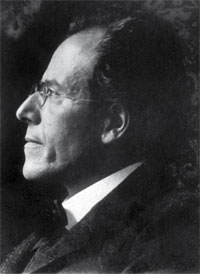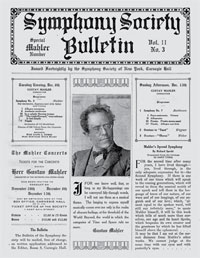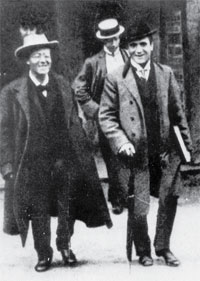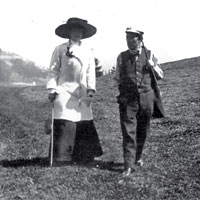Maazel, Mahler, and the New York Philharmonic
The second installment of The Complete Mahler Symphonies, Live includes recordings of Symphonies 6, 7, 8, and 9, along with the Adagio from the unfinished Symphony No.10. The Symphony No.8 in Eb ('Symphony of a Thousand') recording is the most recent addition, and completes the cycle. This set of Mahler symphonies was recorded by Lorin Maazel with the New York Philharmonic between 2003 and 2009, and underscores the special connection between the Philharmonic and the music of Gustav Mahler (1860–1911), who himself was its music director from 1909–1911. Classical Archives is pleased to present this monumental musical offering in a uniquely rich context, combining play buttons for the symphonies, along with the comprehensive liner notes from the Philharmonic's annotator, James M. Keller.
View The Complete Mahler Symphonies, Live Part 1. (Symphonies 1-5) 
 Loading, please wait...
Loading, please wait...Mahler: Symphony No. 6
- 1.Allegro energico, ma non troppo
- 2.Scherzo: Wuchtig
- 3.Andante moderato
- 4.Finale: Allegro moderato. Allegro energico
Recorded live: June 22-25, 2005, Avery Fisher Hall, NY
Liner Notes

Throughout his career Gustav Mahler balanced the competing demands of his vocations as a composer and conductor. Responsibilities on the podium and in the administrative office completely occupied him during the concert season, forcing him to relegate his composing to the summer months, which he spent as a near-hermit in the Austrian countryside. When he came to write his Sixth Symphony, during the summers of 1903 and 1904, he was persevering as director of the Vienna Court Opera, a position he would hold with mounting frustration until 1907. It was a stressful job, and Mahler's anxiety at work led to frequent medical problems.
Fortunately, he could look forward to composing. His summer getaway was then at Maiernigg, a bump on the map on the south shore of the Wörthersee (known sometimes as Lake Worth to English speakers, to the extent that English speakers know it at all), a bucolic spot in the region of Carinthia in southern Austria. In 1901 he had moved into a villa he had built on the lake, and met Alma Schindler the following November, at a dinner party. She was just then concluding a fling with her composition teacher, Alexander von Zemlinsky. Gustav and Alma were smitten with one another and they married a few months later, on March 9, 1902; their first baby, Maria, was born on November 2. A second daughter would arrive during the summer of 1904. Theirs would be a complicated and often unhappy marriage, though they stayed together until Mahler's death, in 1911. (After that, Alma would marry and divorce the architect Walter Gropius, marry and survive the novelist Franz Werfel, and enjoy romantic adventures with several other overachievers in the arts.) As newlyweds the Mahlers already had problems, but these two titanic personalities persevered; she provided some sort of stability that he found useful, while he satisfied her need to be allied with a man of genius.
At Maiernigg Mahler had constructed a small, sparsely furnished composing hut on the hill behind his villa, and every morning he would meander up along a forest path to work in splendid seclusion. The seclusion was mandated: a servant-girl, for example, would leave the villa moments after him on a more direct trail so she could deposit his breakfast at the hut and make her get-away before he arrived. He typically spent some five hours every morning composing there, and the afternoons were given over to hiking, swimming, sunbathing, and other outdoor pursuits.
This was the idyllic world where Mahler's Sixth Symphony came into being, and we may hear a certain measure of loveliness in the score. But that is not the overriding sentiment of this work. On the contrary, this is Mahler's tragic symphony — quite literally, since he appended the subtitle Tragic to the work at its premiere. (He would later withdraw the subtitle, but it reemerged on the printed program the final time he conducted this symphony, lending authority and credibility to its continued widespread use.)
Tragedy surfaces often in Mahler's symphonies, but the composer nearly always uses it as a springboard to triumphant victory (as in his First, Second, Fifth, Seventh, and Eighth Symphonies) or to ecstatic transcendence (as in his Third, Fourth, and Ninth). In the resolutely minor-key Sixth, tragedy persists as the dominant expression to the bitter end. And it is the bitterest of ends: the musical depiction of utter catastrophe, of humanity rendered powerless and insignificant, overwhelmed by forces that seem born of a dimension apart.
Many of Mahler's symphonies might be described as cosmic, but in the Sixth we encounter a cosmos that holds out no hope for mankind. The famous hammer blows near this symphony's conclusion — originally three but reduced in revisions to only two — are among the most shocking and despondent sounds in the entire orchestral repertoire.
The composer initially described each as a "short, powerful but dull-sounding stroke of a non-metallic character," and later added "like the stroke of an axe."
Mahler: Symphony No. 7
- 1.Langsam (Adagio). Allegro con fuoco
- 2.Nachtmusik 1: Allegro moderato
- 3.Scherzo: Schattenhaft, fließend, aber nicht schnell
- 4.Nachtmusik 2: Andante amoroso
- 5.Rondo-Finale: Allegro ordinario
Recorded live: June 20-23, 2007, Avery Fisher Hall, NY
Liner Notes

Throughout his career Gustav Mahler balanced the competing demands of his dual vocation as a composer and conductor. Responsibilities on the podium and in the administrative office completely occupied him during the concert season, forcing him to relegate his composing to the summer months, which he would spend as a near-hermit in the Austrian countryside. He wrote his Seventh Symphony during the summers of 1904 and 1905 — the two Nachtmusik movements in the former year, the other three in the latter — when he was escaping a Vienna that had become a source of considerable stress. He was hanging on to his position as Director of the Vienna Court Opera, infamous then as now as a hotbed of musico-political intrigue, but his anxiety at work, as well as the travel demands of his guest-conducting engagements elsewhere, led to frequent medical problems.
Fortunately, Mahler could look forward to his composing. His summer getaway was then at Maiernigg, a bump on the map on the south shore of the Wörthersee, a bucolic spot in the region of Carinthia in southern Austria. There, Mahler had constructed a tiny, sparsely furnished composing hut on the hill behind his villa, and every morning he would meander up along a forest path to work in splendid isolation. The seclusion was not left to chance: a servant-girl, for example, would leave the villa moments after him on a more direct trail so she could deposit his breakfast at the hut and make her getaway before he arrived. In a letter that he penned in 1910 to his wife, Alma, he recalled how the notes had at first eluded him five years earlier:
I had intended to complete the Seventh [Symphony], for which both Andantes were done. For two weeks I tortured myself to the point of melancholy, as you must remember, until I ran off to the Dolomites! There, the same circus, and finally I gave up and went home, convinced that the summer would be wasted. You did not meet me in Krumpendorf because I had not announced my arrival. I stepped into the boat to be rowed over. At the first stroke of the oars, I hit upon the theme (or rather the rhythm and the style) of the introduction to the first movement, and within four weeks the first, third, and fifth movements were completely finished! Do you remember that?
What Mahler achieved during those two summers continued the path of purely instrumental symphonies that had occupied him in his Fifth (1901–02, a panorama of human emotions) and Sixth (1903–04, a deeply tragic work whose composition overlapped somewhat with his work on the Seventh). His new symphony, it turned out, would prove to be a far more optimistic work than its immediate predecessor; the Seventh essentially traces a path from darkness into light — or, as Mahler described it succinctly to his admirer William Ritter, a Swiss man- about-the-arts: "Three night pieces; the finale bright day. As foundation for the whole, the first movement."
Although Mahler wavered from time to time, he was generally averse to attaching titles to individual movements of his symphonies or to revealing literary or pictorial programs that may have inspired them. Nonetheless, the title Nachtmusik (Night Music) is overtly attached to the second and fourth movements and, as Mahler's comment to Ritter reveals, also informs the third movement. In fact, it seems central to the work's conception and expression that this symphony has sometimes been called (without the composer's blessing) the "Song of the Night." This emphasis on nocturnal nature-music connects Mahler's Seventh to the older tradition of Romanticism. As the Mahler acolyte and conductor Bruno Walter (who would serve as the New York Philharmonic's Music Adviser from 1947 to 1949) explained:
In the three middle movements of the Seventh, meaningfully and humanly revealing, we hear music embodying a Romanticism that we thought had been overcome.
Mahler: Symphony No. 8
- Part 1: Hymnus: Veni, Creator Spiritus
- 1a.Veni, Creator Spiritus
- 1b.Imple superna gratia
- 1c.Infirma nostri corporis
- 1d.Accende lumen sensibus
- 1e.Veni, Creator Spiritus 2
- 1f.Gloria Patri Domino
- Part 2: Final scene of Faust
- 2a-1.Poco adagio
- 2a-2.Waldung, sie schwankt heran
- 2b.Ewiger Wonnebrand
- 2c.Wie Felsenabgrund mir zu Füßen
- 2d.Gerettet ist das edle Glied
- 2e.Uns bleibt ein Erdenrest. Hier ist die Aussicht
- 2f-1.Höchste Herrscherin der Welt
- 2f-2.Dir, der Unberührbar
- 2g.Bei der Liebe, die den Füßen
- 2h-1.Neige, neige, Du Ohnegleiche
- 2h-2.Komm! Hebe dich zu höhern Sphären!
- 2i.Blicket auf zum Retterblick
- 2j.Alles Vergängliche
Recorded live: June 24–27, 2009, Avery Fisher Hall, NY
Liner Notes

Today Gustav Mahler is universally recognized as one of the supreme masters of the symphony, but this status was hard-won, and, for the most part, posthumous. His First Symphony was such a disastrous failure at its premiere in 1889 that afterward, by the composer's own account he "went around like a sick person or an outcast."
Not until the premiere of his complete Third Symphony, in 1902, did Mahler score a firm success with a symphony, but that would remain the exception rather than the rule as he continued to unveil his works. His Eighth Symphony, happily, proved to be another exception. Its premiere was an unmitigated triumph; and, although it is far from his most performed symphony – its exorbitant physical demands make it strictly a "special occasion" work – audience enthusiasm has only increased through the century since it was introduced. (The concerts heard in this recording certainly followed the tradition of a special occasion, as they were Lorin Maazel's final performances with the New York Philharmonic as the Orchestra's Music Director.)
The symphony's personnel requirements are indeed extraordinary. Its premiere included the participation of 858 singers and 171 instrumentalists (plus one conductor – Mahler himself). The composer first broached the possibility of this work in a 1906 letter to the Munich impresario Emil Gutmann. He proposed his availability to conduct concerts in that city in the fall of 1910 and added: "I would be in a position to offer you a fairly large new work." Plans proceeded in an on-again, off-again fashion until a date was eventually set and Gutmann began lining up a huge roster of musicians. It was Gutmann's job to sell this huge and potentially perilous venture to the concert-going public, and, in the event, he could not resist dubbing the piece the "Symphony of a Thousand." Mahler was displeased when he learned of this marketing motto, despite the fact that it was demonstrably true – and even an understatement by 30 bodies. The nickname proved durable, and there's no harm in it except that it has invited the occasional misunderstanding that Mahler considered such vast forces necessary for the performance of the piece, which is not at all the case. The majority of performances since then have involved considerably more modest forces (though the numbers are still extravagant by objective standards); the performances heard in this recording included a total of 350 singers and instrumentalists, plus one conductor.
In this work Mahler returns to the "vocal symphony," an idea that he had explored in his Second, Third, and Fourth Symphonies but then abandoned by returning to strictly instrumental forces for his next three. The Eighth is the "most vocal" of all of his symphonies: singing pervades the work practically throughout. The piece is cast in two unequal parts that, on the surface, seem not to be much connected. The opening movement, which runs some 23 minutes, is a setting for chorus and orchestra of the medieval text Veni, creator spiritus, a hymn for Pentecost in which the "Creator Spirit," the "highest gift of God," is invited to infuse the human soul with grace, light, strength, and speech – in short, to endow people with the characteristics that should define humanity. (Mahler made loose use of the official text, altering some words and the order of some lines.) The second part, which is almost an hour long, is given over to the closing scene from the Second Part of Faust, the dramatic poem by Johann Wolfgang von Goethe (1749–1832) – a work of awesome cultural significance in German-speaking nations. Here we find Faust, the embodiment of human striving, at the point of his death, having committed many moral transgressions motivated by his questing ambition. In this almost operatic finale we follow his spirit as it ascends toward redemption in Heaven, rising from the depth of mountain gorges past various on-looking characters into the realm of the higher angels and, finally, into the presence of the Mater gloriosa, the Holy Virgin herself, with whom the spirit of Faust's much-wronged lover, Gretchen, intercedes, praying that the love she and Faust once shared might earn his redemption and his admission to "higher spheres."
Mahler: Symphony No. 9
- 1.Andante comodo
- 2.Im Tempo Eines Gemachlichen Landlers. Etwas Tappisch Und Sehr Derb
- 3.Rondo-Burleske. Allegro Assai. Sehr Trotzig
- 4.Adagio. Sehr Langsam Und Noch Zuruckhaltend
Recorded live: June 4-13, 2008, Avery Fisher Hall, NY
Liner Notes

Throughout his career Gustav Mahler balanced the competing demands of his dual vocation as a composer and conductor. Responsibilities on the podium and in the administrative office completely occupied him during the concert season, thereby forcing him to relegate his composing to the summer months, which he would spend as a near-hermit at some idyllic spot in the countryside. Mahler wrote his Ninth Symphony mostly during the summer of 1909 at Alt-Schluderbach near Toblach, an Italian community in South Tyrol, on the border with Austria in the Dolomite Alps. He had constructed a studio for composition, set at the edge of a spruce forest, not far from the home he and his wife, Alma, rented; a fence topped with barbed wire ensured that no one could interrupt him while he worked, which he did beginning at 6:00 a.m. every morning. Gustav and Alma had already spent the summer of 1908 at this retreat, where he recharged himself after an extended visit to conduct various works at The Metropolitan Opera in New York. He was back in New York for the 1908 season, conducting the New York Symphony as well as at The Met, and near the end of the season he also led the New York Philharmonic, which he had agreed to take over as music director beginning in the fall of 1909. The composition of the Ninth Symphony therefore coincided with the beginning of his New York Philharmonic years, which would be regrettably brief, ending after only two seasons with his death in May 1911.
On April 1, 1910, Mahler wrote to his amanuensis, the conductor Bruno Walter, to report that he had completed his Ninth Symphony. "In it," he declared, "something is said that I have had on the tip of my tongue for some time; perhaps (as a whole) it comes closest to the 4th. (But it is completely different.)" Indeed, this heartrending revelation of Mahler's soul is "completely different" from the often dreamlike expanses of his fairy-tale Fourth (which preceded the Ninth by a decade). Nevertheless, the two do have something in common: they share the sense of conveying thoughts about the transience of life — perhaps somewhat fancifully in the Fourth, certainly with unrestrained emotion and sentiment in the Ninth.
Mahler was pushing himself to his limit through his hyperfilled calendar of conducting commitments, not to mention the physical and intellectual drain of his composing, and he was doing so against doctors' orders. The year 1907 had been a cruel one for Mahler: in addition to his break from the musical life of Vienna, where he had been based for years, he lost his eldest daughter to scarlet fever; then, that summer, he had learned that he was suffering from heart disease (a valvular defect) that, while not likely to prove immediately fatal, was potentially dangerous and could well shorten his life. An outdoor enthusiast, he was forced to curtail his physical activities drastically.
Against such a background, the composition of a ninth symphony held other troubling prospects as well. Beethoven, Schubert, and Dvorˇák had all brought their symphonic cycles to completion with their Ninth Symphonies, and Bruckner had died before quite finishing his. To Mahler, who had begun to cultivate a superstitious streak, the very idea of a ninth symphony therefore summoned up thoughts of mortality. On the other hand, pretty much everything summoned up thoughts of mortality for Mahler, but at this point he was not ready to give in to fate. When he completed his Ninth Symphony he was still three months short of his 50th birthday, and upon finishing it he promptly plunged into the composition of yet another symphony.
Sadly, Mahler's Tenth would remain an incomplete torso, leaving his Ninth to stand as a poignant swan song. That the composer viewed this work as a sort of leave-taking seems beyond debate: its principal theme is derived from Beethoven's Farewell (Les Adieux) Piano Sonata, and the symphony — particularly its opening and concluding movements, both of which are slow — is filled with intimations of yearning, nostalgia, regret, despair, isolation, resignation, and even personal solace.
Mahler: Symphony No. 10 Adagio
- 1.Adagio
Recorded live: September 25-28, 2008, Avery Fisher Hall, NY
Liner Notes

Gustav Mahler was far more widely applauded as a conductor than as a composer during his lifetime. Conducting and administrative responsibilities occupied him almost completely during the concert season, forcing him to relegate most of his composing to the summer months, which he would spend with his family at some idyllic rural retreat. Mahler's Tenth Symphony unrolled during the summer of 1910 at Alt-Schluderbach near Toblach, an Italian community in South Tyrol, on the border with Austria in the Dolomite Alps. He had constructed a studio for composition, set at the edge of a spruce forest, not far from the home he and his wife, Alma, rented; a fence topped with barbed wire insured that no one could interrupt him while he worked, which he did beginning at six o'clock every morning. He and Alma had first spent time there in the summer of 1908, before Mahler returned to New York for the 1908–09 Season to conduct the New York Symphony as well as at The Metropolitan Opera. Near the end of the season he also led the New York Philharmonic, which he had agreed to take over as Music Director beginning in the fall of 1909. His work on the Tenth Symphony therefore fell midway in his New York Philharmonic tenure, which would be regrettably brief, ending, after only two seasons, with his death in May 1911.
Had he lived through the summer, Mahler likely would have completed this symphony. In the event, he left it as a magnificent torso, a five-movement masterpiece-in-the-making consisting of a vast opening Adagio, a Scherzo, a central movement titled Purgatorio (inspired by a poem of the Polish writer Adam Mickiewicz, in a German translation by Siegfried Lipiner), a second Scherzo, and a Finale — the entire work running perhaps 80 minutes. This, at least, was how the movements stood at his death; given the composer's tendency to rethink the sequencing of movements in his symphonies, this layout must be considered provisional. The Adagio reached the most finished form, with each ensuing movement successively less complete.
It's surprising that Mahler got as much work done on his Tenth Symphony as he did during the summer of 1910. Following his return from New York at the end of April he was occupied with preliminary rehearsals, in Munich, for the upcoming premiere of his Eighth Symphony, and he did not arrive in Toblach until the end of June. At the beginning of September he was back in Munich, where the Eighth Symphony was premiered on September 12. That meant that only July and August were free for work on the Tenth. Furthermore, it was at just that time that he discovered that his wife was having an affair with the architect Walter Gropius (whom she August 26, with another vacationing Viennese luminary, Dr. Sigmund Freud, who diagnosed a compulsion neurosis and — surprise! — a mother fixation. (Alma conveniently explained the trip as arising from Mahler having recognized "that he had led the life of a psychopath.") Two days later Mahler was back in Toblach, and in another week he left for Munich.
The Tenth Symphony, therefore, developed during a time of intense personal turmoil, and the later movements of the work reveal this overtly through the composer's having peppered them with anguished comments such as "O God, O God, why hast thou forsaken me?". "To live for you, to die for you," and, most poignantly, "Almschi!," his nickname for the beloved wife whom he feared he was losing. The manuscript of the Adagio (perhaps drafted before the incident with Alma erupted) sports no such inscriptions, but it reveals Mahler's emotional state just as surely, embracing both high-anxiety panic and melting tenderness. Even if we assume that Mahler would have altered its details before signing off on it, we can accept it as a complete expression of his innermost soul.



















